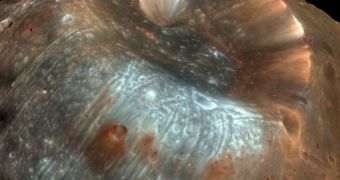An orbiter operated by the European Space Agency (ESA) around Mars has recently captured a new series of images of one of the least reflective bodies in the solar system, the moon Phobos. The object is the target of an upcoming Russian sample-return mission.
Phobos is the largest moon around the Red Planet, experts say, and it is such an object of interest precisely because scientists don't really know its structure and how it was formed originally.
Over the years, a number of spacecraft have looked at the moon, but now the Mars Express space probe managed to get within 100 kilometers of Phobos' surface. The flyby took place on January 9.
As the spacecraft approached its target, it was able to use its science payload to collect a variety of readings of Phobos, including images of the planned landing site that the Russians plan to use for their Phobos-Grunt mission.
The new flyby also had another practical application, as it helped investigator settle the debate as to the origins of Phobos. Some believed that it was an asteroid trapped by Mars' gravity, whereas others said it might have coalesced from the same material its parent planet did.
But the new studies demonstrate that the object was in fact produced when a very large asteroid or comet struck the Red Planet, ejecting debris into its lower orbits. Later on, these debris came together to form Phobos.
This also helps explain the loose make-up of the Moon, which is not a solid block of rock. This would be the case if the object was indeed a captured asteroid. The fact that it's made up of loosely-bound space rocks further contributes to verify the aforementioned hypothesis.
“We detected for the first time a type of mineral called phyllosilicates on the surface of Phobos, particularly in the areas northeast of Stickney, its largest impact crater,” explains Dr Marco Giuranna.
“These phyllosilicate rocks are thought to form in the presence of water, and have been found previously on Mars. This is very intriguing as it implies the interaction of silicate materials with liquid water on the parent body prior to incorporation into Phobos,” he adds.
“Alternatively, phyllosilicates may have formed in situ, but this would mean that Phobos required sufficient internal heating to enable liquid water to remain stable,” he goes on to say, quoted by Daily Galaxy.
The expert is a coauthor of a new study detailing the findings. He is based at the Italian National Institute for Astrophysics in Rome. Working together with other researchers, Dr Giuranna browsed the Mars Express readings to arrive at the new conclusions.

 14 DAY TRIAL //
14 DAY TRIAL //